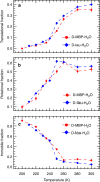Translational diffusion of hydration water correlates with functional motions in folded and intrinsically disordered proteins
- PMID: 25774711
- PMCID: PMC4382692
- DOI: 10.1038/ncomms7490
Translational diffusion of hydration water correlates with functional motions in folded and intrinsically disordered proteins
Abstract
Hydration water is the natural matrix of biological macromolecules and is essential for their activity in cells. The coupling between water and protein dynamics has been intensively studied, yet it remains controversial. Here we combine protein perdeuteration, neutron scattering and molecular dynamics simulations to explore the nature of hydration water motions at temperatures between 200 and 300 K, across the so-called protein dynamical transition, in the intrinsically disordered human protein tau and the globular maltose binding protein. Quasi-elastic broadening is fitted with a model of translating, rotating and immobile water molecules. In both experiment and simulation, the translational component markedly increases at the protein dynamical transition (around 240 K), regardless of whether the protein is intrinsically disordered or folded. Thus, we generalize the notion that the translational diffusion of water molecules on a protein surface promotes the large-amplitude motions of proteins that are required for their biological activity.
Figures





References
-
- Ball P. Water as an active constituent in cell biology. Chem. Rev. 108, 74–108 (2008) . - PubMed
-
- Rupley J. A. & Careri G. in Advances in Protein Chemistry Vol. 41, eds Anfinsen C. B., Edsall J. T., Richards F. M., Eisenberg D. S. 37–172Academic Press (1991) . - PubMed
-
- Doster W. & Settles M. Protein-water displacement distributions. Biochim. Biophys. Acta 1749, 173–186 (2005) . - PubMed
Publication types
MeSH terms
Substances
LinkOut - more resources
Full Text Sources
Other Literature Sources

